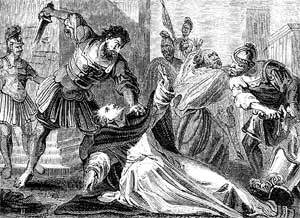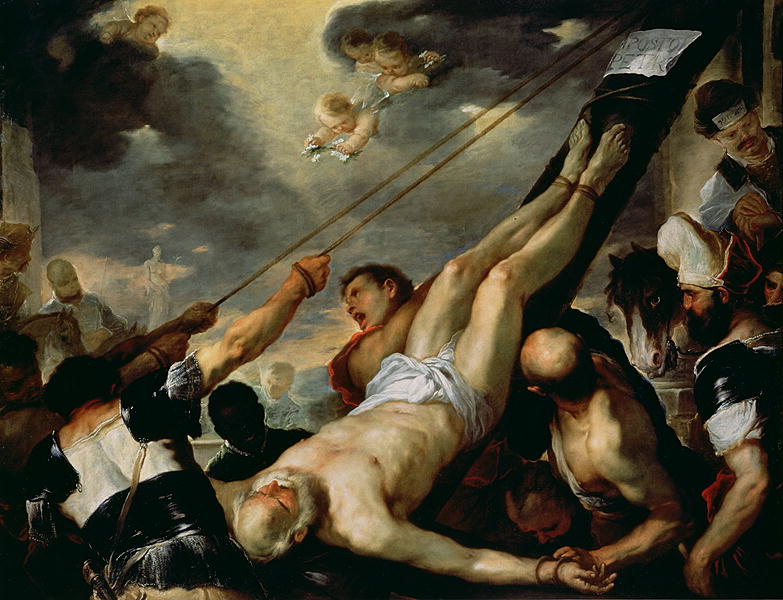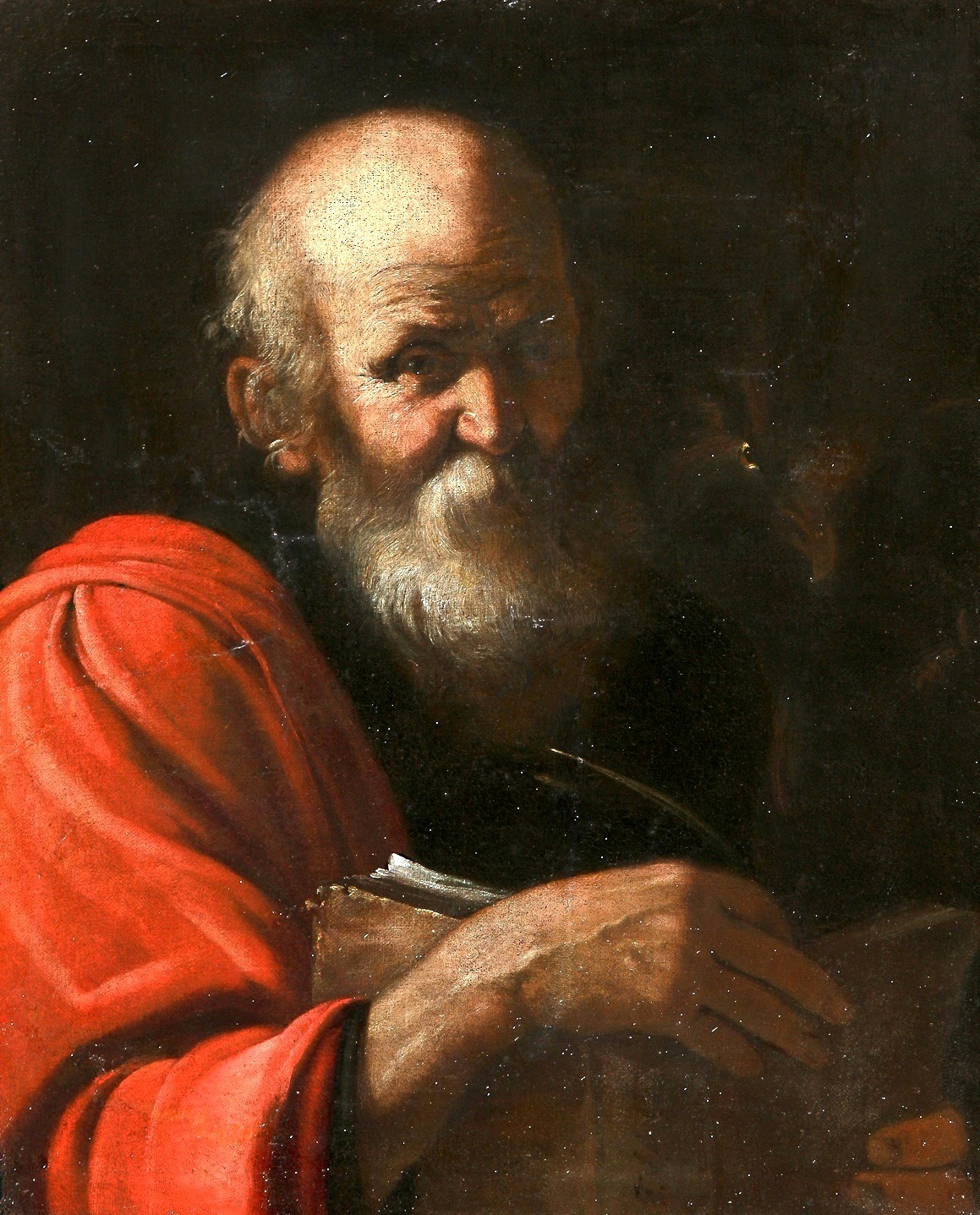PERSECUTION OF CHRISTIANS DEATH OF PETER AND PAUL
Eusebius, Hist. Ec., II, 25. (MSG, 20:207.) Cf. Mirbt, n. 33.
the merits of Eusebius as a historian, see McGiffert's edition
Dionysius, Bishop of Corinth, was a contemporary of Soter, Bishop of Rome, 166-174 A. D., whom he mentions in an epistle to the Roman Church. Of his epistles only fragments have been preserved; see Krüger, § 55. The following extract from his epistle to the Roman Church is the earliest explicit statement that Peter and Paul suffered ]martyrdom at the same time or that Peter was ever in Italy. In connection with this extract, that from Clement of Rome
Paul was beheaded at Rome itself, and that Peter was crucified likewise at the same time
 APOSTLE Paul was beheaded
APOSTLE Paul was beheaded
Peter was crucified
The Death of the Apostle John

APOSTLE JOHN
Irenæus was bishop of Lyons soon after 177. He was born in Asia Minor about 120, and was a disciple of Polycarp (ob. circa 155) and of other elders who had seen John, the disciple of the Lord.
Those in Asia associated with John, the disciple of the Lord, testify that John delivered it [a tradition regarding the length of Christ's ministry] to them. For he remained among them until the time of Trajan [98-117 A. D.]
When the holy Evangelist John had lived to extreme old age in Ephesus, he could be carried only with difficulty by the hands of the disciples, and as he was not able to pronounce more words, he was accustomed to say at every assembly, “Little children, love one another.” At length the disciples and brethren who were present became tired of hearing always the same thing and said: “Master, why do you always say this?” Thereupon John gave an answer worthy of himself: “Because this is the commandment of the Lord, and if it is observed then is it enough.”
The time of John's death has been given in a general way,1 but his burial-place is indicated by an epistle of Polycrates (who was bishop of the parish of Ephesus) addressed to Victor of Rome, mentioning him, together with the Apostle Philip and his daughters, in the following words: “For in Asia also great lights have fallen asleep, which shall rise again at the last day, at the coming of the Lord, when he shall come with ]glory from heaven and seek out all the saints. Among these are Philip, one of the twelve Apostles, who sleeps at Hierapolis, and his two aged virgin daughters, and another daughter who lived in the Holy Spirit and now rests at Ephesus; and moreover John, who was both a witness and a teacher, who reclined upon the bosom of the Lord, and being a priest wore the high priest's mitre, also sleeps at Ephesus.”
The Persecution under Domitian
At that time (95) the road which leads from Sinuessa to Puteoli was paved. And in the same year Domitian caused Flavius Clemens along with many others to be put to death, although he was his cousin and had for his wife Flavia Domitilla, who was also related to him. The charge of atheism was made against both of them, in consequence of which many others also who had adopted the customs of the Jews were condemned. Some were put to death, others lost their property. Domitilla, however, was only banished to Pandataria.
To such a degree did the teaching of our faith flourish at that time2 that even those writers who were far from our [religion did not hesitate to mention in their histories the persecutions and martyrdoms which took place during that time. And they, indeed, accurately indicate the time. For they record that, in the fifteenth year of Domitian, Flavia Domitilla, daughter of a sister of Flavius Clemens, who was at that time one of the consuls of Rome, was exiled with many others to the island of Pontia3 in consequence of testimony borne to Christ.

Justin Martyr was born about 100 in Samaria. He was one of the first of the Gentiles who had been trained in philosophy to become a Christian. His influence upon the doctrinal development of the Church was profound. He died as a martyr between 163 and 168. His principal works are the two Apologies written in close connection under Antoninus Pius (138-161), probably about 150, and his dialogue with Trypho the Jew, which was written after the first Apology. All translations of Justin Martyr are based upon Otto's text, v. supra.
Martyrdom of Polycarp

Polycarp, Bishop of Smyrna, died at Smyrna February 2, 155, at the age of at least eighty-six, but he was probably nearer one hundred years old. He was the disciple of John, probably same as the Apostle John. His epistle was written circa 115, soon after the death of Ignatius of Antioch. At present it is generally regarded as genuine, though grave doubts have been entertained in the past. The martyrdom was written by some member of the church at Smyrna for that body to send to the church at Philomelium in Phrygia, and must have been composed soon after the death of the aged bishop. It is probably the finest of all the ancient martyrdoms and should be read in its entirety.
The whole multitude both of the heathen and the Jews who dwelt at Smyrna cried out with uncontrollable fury and in loud voice: “This is the teacher of Asia, the father of the Christians and the overthrower of our gods, who teaches many neither to sacrifice nor to worship.” Saying these things, they cried out and demanded of Philip, the Asiarch, to let a lion loose upon Polycarp. But he said he could not do this, since the sports with beasts had ended. Then it pleased them to cry out with one consent that he should burn Polycarp alive.
These things were carried into effect more rapidly than they were spoken, and the multitude immediately gathered together wood and fagots out of the shops and baths, and the Jews especially, as was their custom, assisted them eagerly in it.
Walang komento:
Mag-post ng isang Komento